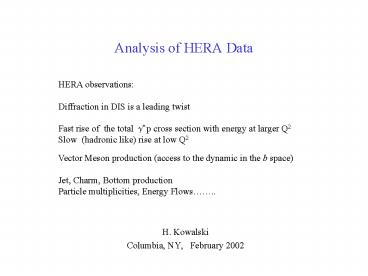Analysis of HERA Data - PowerPoint PPT Presentation
1 / 22
Title:
Analysis of HERA Data
Description:
HERA Interactions. Collisions of e (e-) of 27.5 GeV with p of 920 GeV ... Dynamics of diffraction at HERA can be described by few Feynman diagrams ... – PowerPoint PPT presentation
Number of Views:77
Avg rating:3.0/5.0
Title: Analysis of HERA Data
1
Analysis of HERA Data
HERA observations Diffraction in DIS is a
leading twist Fast rise of the total g p
cross section with energy at larger Q2 Slow
(hadronic like) rise at low Q2 Vector Meson
production (access to the dynamic in the b
space) Jet, Charm, Bottom production Particle
multiplicities, Energy Flows..
- H. Kowalski
- Columbia, NY, February 2002
2
Papers J.Bartels, J.Ellis, H.Kowalski, M.
Wuesthoff , EPJ-C7 443 (1999)K.
Golec-Biernat, M. Wuesthoff , Phys.Rev. D59
(1999) 014017 H. Kowalski. M. Wuesthoff,
Liverpool 2001-DIS 192 A. Caldwell, M. Soares,
Nucl. Phys. A696 (2001) 125 J.Bartels,
H.Kowalski , EPJ-C19 693 (2001)J.Bartels, K.
Golec-Biernat, H.Kowalski, in preparation
(2002)
3
HERA Interactions
Collisions of e (e-) of 27.5 GeV with p of
920 GeV
4
Diffraction in DIS
Diffraction Incoming proton remains intact after
the scattering and carry more than 99 of its
momentum. How is it possible that the incoming
proton remains intact ? Confinement forces drag
the cloud back into a few outgoing
hadrons Dynamics of diffraction at HERA can be
described by few Feynman diagrams extrapolated to
the nonperturbative limit (aligned jets).
5
Total gp Cross Section
Proton Rest
Frame incoming virtual photon fluctuates into a
quark-antiquark pair which in turn emits a
cascade-like cloud of gluons
Transverse size of the quark-antiquark cloud is
determined by r 1/Q 2 10-14cm/ Q (GeV)
Successive emission of gluons leads to rise of
the cross section with W
DGLAP gt
l is a measure of the radiation intensity
6
Dipole description of DIS
7
GBW Model K. Golec-Biernat, M. Wuesthoff
Size of r determined by the wave
function perturbative region r ltlt
2R0 saturation region r gtgt 2R0
Saturation radius
from DIS data sqq x-0.3 in the
perturbative region gt Assumption
Parameters fitted to DIS data s0 23 mb l
0.29 x0 0.0003
8
Parameters fitted to HERA DIS data c2 /N 1
s0 23 mb l 0.29 x0 0.0003
9
Diffractive Measurement in DIS
xIP is fraction of protons momentum carried by
the gluon cloud (pomeron) b is fraction of
pomerons momentum carried by the struck quark
10
Saturation Model Predictions for
Diffraction
11
Approximate relationships
Note maxz(1-z) 1/4
symmetric aligned
(suppression for rgtgt1/Q)
12
Saturation Effects
The rise of the cross section with energy cannot
continue forever when the gluon density of a
single cascade becomes too high a second cascade
develops
the pairwise (coherent) interaction of cascades
with the proton leads to negative interference
which damps the growth of the cross section
13
DGLAP evolution in the Saturation Model
In the Saturation Model for small r
Dipole cross section in the small-r region
Modification of the model
with xg(x, ) evolving according to DGLAP
equations from
14
Fits to new data
mq 140 MeV Original GBW Saturation
Model c2/N 2.4 Saturation Model with
evolution c2/N 1.2
s0 23 mb l 0.28 A0.029 C 0.26 Q02
0.5 GeV2
15
Fits to new data
mq 0 Saturation Model with
evolution c2/N 1.0
s0 23 mb l 0.0 A 0.098 C 1.0 Q02
1.0 GeV2
16
Inclusive Diffraction Mx- Method
17
Inclusive Diffraction LPS - Method
18
Dipole Cross Section
19
Gluon Amplitude f(x,l2) in the Saturation Model
Dipole cross section in momentum space
Doing the angular integration
Approximating
we find for large l2
f(x,l2) coincides with the un-integrated gluon
distribution
Saturation without evolution
20
mq 140 MeV
mq 0 MeV
saturation
21
(No Transcript)
22
(No Transcript)































